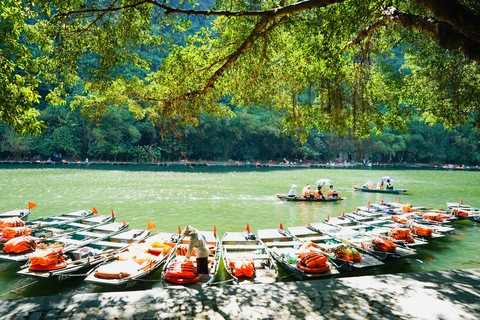
Trang An eco-tourism site, part of the Trang An Landscape Complex in northern Ninh Binh Province. Local tourism market has been proved as a lifesaver in difficulty of COVID-19. — VNS/ Photo Thanh Hai
Nguyen Anh Tuan, Director of the Vietnam Institute of Tourism Development, said through crises such as COVID-19, the domestic tourism market was the saviour of the tourism industry and a fast recovering market, regaining growth momentum beyond expectations.
Through research on the domestic tourist market in 2016-2022 on a national scale, domestic tourism has taken an active role in each development stage. The number of domestic tourists has increased steadily over the years and peaked in 2019 with 85 million arrivals.
In the first ten months of 2022, the number of domestic tourists reached 91.8 million, surpassing the whole figure of 2019.
Tuan said: "The double-digit annual growth shows the amazing development of the tourism industry."
Domestic tourists are increasingly contributing positively to the total revenue of the tourism industry. In 2015, domestic tourists only contributed VND158 trillion (US$6.86 billion) to the total revenue of the whole industry. In 2019, it increased 2.1 times to reach VND334 trillion. The average growth was about 20.5 per cent per year, and revenue from domestic tourism accounted for about 41-44 per cent of the total revenue structure of the industry.
However, if compared with countries in Southeast Asia, both the total number of visitors and the total revenue from domestic tourists still have room to improve. For example, the spending of domestic tourists averaged VND977,700 per day in 2011 and VND1.15 million by 2020.
Domestic tourists often travel during the summer and major holidays, such as New Year's Day, Lunar New Year, April 30 and May 1, and weekends. Most of them go with groups of friends and family, with an average trip length of four to four days in summer and one to three days during holidays.
Their destinations are beach and mountain resorts across more than a dozen localities. Many localities have good tourism potential but are empty due to unfavourable traffic and underdeveloped infrastructure. The institute said the type of tourism for local travellers was not diverse and rich.
According to Assoc. Prof-Dr. Pham Hong Long, Dean of the Faculty of Tourism, Hanoi University of Social Sciences and Humanities, states that due to the impacts of the COVID-19 pandemic, Viet Nam's tourism is too dependent on international revenue. At the same time, the huge domestic market is left untapped.
In 2022, the tourism industry aims to welcome 65 million visitors, including five million international visitors, bringing in revenue of VND400 trillion.
"Domestic tourism is still the industry's key market," Long said.
To attract domestic tourists, programmes need to be more innovative and creative in approaching destinations, moving and using services. Based on the trend shift of tourists in the new normal, travel businesses need to focus on building groups of products with an emphasis on experiences suitable for different customer groups.
Besides the high mass tourism product lines such as sea tourism, spiritual, cultural tourism, festivals, urban tourism, night tour and culinary tourism, Long emphasised: "New trending tourism product lines need to be developed more after the COVID-19 period, based on the characteristics of tourists' tastes and preferences. That tourism is a product of high-class resort, care, health, treatment, eco-tourism, community-based tourism, sports, and smart tourism."
In the context of the new normal, guests' needs and consumption habits have changed a lot. To promote the development of domestic tourism, Tuan from the institute said the Ministry of Culture, Sports and Tourism should direct the Vietnam National Administration of Tourism to develop separate and specific mechanisms and policies for the domestic tourist market to promote strong and sustainable development of domestic tourism activities in the new conditions.
In addition, it is necessary to diversify products and be bold in the local area, to develop forms of health care tourism, cultural tourism, traditional craft village tourism, art tourism, and tourism, ecology, adventure sports tourism, Tuan said.
At the same time, the tourism industry encourages new products in areas with difficulties but with tourism potential in the northern mountainous provinces, the Central Highlands provinces and the Mekong River Delta.
To develop sustainable domestic tourism, localities should strengthen the capacity of destination management and safe tourism services and effectively implement the code of conduct in tourism activities, establishing and connecting networks in promoting domestic tourism.
They must also focus on market research and tourism promotion. — VNS